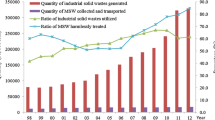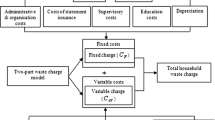Abstract
This study attempted to calculate the amount of waste generated by the residents, households and commercial businesses in Songkhla and Hat Yai cities under three potential scenarios: (1) status quo—no charge for waste collection service (current situation); (2) an equal fee charging rate for constituents of both Songkhla and Hat Yai cities as stated in the Public Health Law of Thailand; (3) a different waste collection fee within the cities of Songkhla and Hat Yai as proposed and concluded in the study of Siritorn (Presented at the APBERS conferences in Japan, 2017, Ritsumeikan Asia Pacific University, Beppu, 2017). The regression results of the double-log model indicated that different optimal rates for waste collection fee in each city would decrease the waste produced in Songkhla by 162 kg per day and decrease waste production by 503 kg per day in Hat Yai. As a result, the two municipalities could generate a double benefit of (1) savings from total expenditure on waste management and (2) savings from the adjustment of behaviour of the residents to create a decrease in the present waste production total amounts. In summary, the “different” fee policy strategy created a win–win situation for the municipalities.
Similar content being viewed by others
References
Siritorn K (2017) House and area characteristics, the effects on willingness to pay for a municipal waste collection fee in Songkhla and Hat Yai Cities, Thailand. In: Presented at the APBERS Conferences in Japan, 2017, Ritsumeikan Asia Pacific University, Beppu
Ochiai Y (2003) PAYT: development and challenges. J Jpn Waste Manag Assoc 56(256):507–510
Oates EW, Baumol JW (1975) The instruments for Environment Policy. National Bureau of Economic Research (NBER). http://www.nber.org/books/mill75-1. Accessed 15 Mar 2017
Hogg D, Sherrington C, Vergunst T (2011) A comparative study on economic instruments promoting waste prevention. Eunomia Research and Consulting Ltd. http://www.eunomia.co.uk/reports-tools/a-comparative-study-on-economic-instruments-promoting-waste-prevention-2/. Accessed 17 Jan 2017
Pearce DW, Turner RK (1990) Economics of natural resources and the environment. The Johns Hopkins University Press, Great Britain
Tietenberg T (2000) Environmental and natural resource economics. Addison-Wesley, New York
Lu W, Peng Y, Webster C, Zuo J (2015) Stakeholders’ willingness to pay for enhanced construction waste management: a Hong Kong study. Renew Sustain Energy Rev 47:233–240
Ferreira S, Marques RC (2015) Contingent valuation method applied to waste management. Resour Conserv Recycl 99:111–117
Afroz R, Hanaki K, Hasegawa-Kurisu K (2009) Willingness to pay for waste management improvement in Dhaka city, Bangladesh. J Environ Manage 90:492–503
Songkhla Municipal Office (2016) Songkhla Municipality Report 2016, Songkhla Municipal Office Website. http://www.songkhlacity.go.th. Accessed 15 Mar 2017
Hat Yai Municipal Office (2016) Hat Yai Municipality Report 2016, Hat Yai Municipal Office Website http://www.Hatyaicity.go.th. Accessed 15 Mar 2017
Eshet T, Baron MG, Shechte M, Ayalon O (2007) Measuring externalities of waste transfer stations in Israel using hedonic pricing. Waste Manag 27:614–625
Karagiannidis A, Xirogiannopoulou A, Moussiopoulos N (2006) On the effect of demographic characteristics on the formulation of solid waste charging policy. Waste Manag 26:110–122
Fernandez-Aracil P, Ortuno-Padilla A, Melgarejo-Moreno J (2018) Factors related to municipal costs of waste collection service in Spain. J Clean Prod 175:553–560
Heller MH, Vatn A (2017) The divisive and disruptive effect of a weight-based waste fee. Ecol Econ 131:275–285
Sakai S, Ikematsu T, Hirai Y, Yoshida H (2008) Unit-charging programs for municipal solid waste in Japan. Waste Manag 28:2815–2825
Beukering PJH, Bartelings H, Linderhof VGM, Oosterhuis FH (2009) Effectiveness of unit-based pricing of waste in The Netherlands: applying a general equilibrium model. Waste Manag 29:2892–2901
Edjabou ME, Boldrin A, Astrup TF (2018) Compositional analysis of seasonal variation in Danish residual household waste. Resour Conserv Recycl 130:3–11
Younes MK et al (2016) Landfill area estimation based on integrated waste disposal options and solid waste forecasting using modified ANFIS model. Waste Manag 55:3–11
Fu HZ, Li ZS, Wang RH (2015) Estimating municipal solid waste generation by different activities and various resident groups in five provinces of China. Waste Manag 41:3–11
Acknowledgements
This study was fully supported by the Higher Education Commission, Thailand, and the Thailand Research Fund under Grant no. MRG5980227. The authors also would like to thank the Faculty of Management Sciences, Songkhla Rajabhat University for research facilities.
Author information
Authors and Affiliations
Corresponding author
Additional information
Publisher's Note
Springer Nature remains neutral with regard to jurisdictional claims in published maps and institutional affiliations.
Rights and permissions
About this article
Cite this article
Siritorn, K., Permpoonwiwat, C.K. Effects of area characteristics and municipal waste collection fees on household waste generation. J Mater Cycles Waste Manag 22, 89–96 (2020). https://doi.org/10.1007/s10163-019-00917-2
Received:
Accepted:
Published:
Issue Date:
DOI: https://doi.org/10.1007/s10163-019-00917-2




